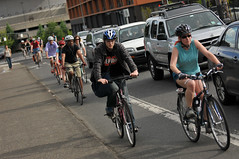New data released by the U.S. Census Bureau’s American Community Survey shows that the state of Oregon is a national leader in the number of people who ride a bicycle to work.
According to the new “Journey to Work” numbers, 6 percent of people in the city of Portland use a bicycle as their main mode of transportation to work. That’s the highest number of the top 70 largest cities in the country. Oregon also led the way in metro areas of all sizes with the Corvallis and Eugene areas taking the top two spots with 9.3 and 6 percent respectively.

Portland’s numbers represent a 0.2 percent jump from last year. According to analysis by the League of American Bicyclists, Census results show that the amount of people biking to work in Portland has increased 71 percent since 2005 and 231 percent since 2000.
The Census data also showed that 59 percent of Portlanders drive alone to work and 12 percent take public transportation. (That drive alone number is 2 percent lower than 2009.)
Statewide, the Census found that the 2.2 percent of Oregonians primarily bike to work while 4.2 percent take public transit and 72 percent drive.
Nationally, just a paltry 0.6 percent of workers use a bike as their primary way to get to work. “While this number represents nearly 40 percent growth since 2000,” says the League, “it also shows that we still have a lot of work to do in making our communities truly welcoming to bicyclists.”
Um yeah. I’ll say.
For another look at the numbers, check out the graph below created by Bikes Belong. It compares trends in bike commuting nationwide:

Interestingly, The Oregonian reported this morning that the Census numbers reflect how the Portland Metro-area is “car-dependent” and that commuters “love their cars… despite a big push to build bicycle lanes and light-rail lines in recent years.”
That framing of the data has, not surprisingly, led some predictable reactions both in the story comments and from local car advocates.
For more on this year’s numbers, including spreadsheets with data from other cities and an explanation of caution about Census data, see the League’s blog post.


